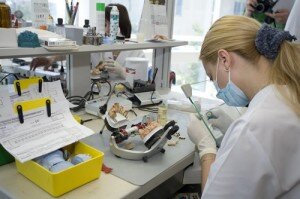However, such treatments are associated not only with positive results, but also with enormous risks. Botox, for example, is one of the strongest known neurotoxins: the toxin formed by the bacterium Chlostridium botulinum can be lethal if absorbed subcutaneously at quantities of more than 4 nanograms (equivalent to 0.0004 mg) per kilogram of bodyweight. Though medical Botox is strongly diluted, it is still associated with some dangers, since the dilution does not remove the neuroparalytic and response-inhibiting effects.
What’s more, the cosmetic surgeon can only solve the problem at a superficial level, while the root of the aging process lies deeper – including in the jaw and teeth. Bone resorption is the true cause of numerous age-related changes in the face. If the patient has missing teeth or incorrectly positioned prostheses, the jawbone will degenerate slowly due to lack of chewing pressure and wobbly dentures and drastic visual changes will result. The cheeks look looser and less full, the maxilla (upper jaw) retreats noticeably and the the lips appear to sink inwards, making them look thinner.

A treatment can only correct these “internal” changes if it addresses the underlying dental problem and creates a solid foundation. The first stage in any such treatment should be a precise analysis of the patient’s dental situation. In order to guarantee an effective and – above all – long-term solution, each tooth should be assessed and accounted for within the treatment plan. During this process, the dentist must consider not only whether bone resorption has already taken place, but also whether the patient has dentures, loose teeth or signs of periodontitis. All these factors contribute to destabilisation of the jaw and hinder the treatment.
“To perform dental reconstructions, we require a basic level of stability”, explains Dr. Regina Schindjalova, director of the Dentaprime Clinic. “This applies for both the use of implants and for supraconstruction procedures.”
This, in turn, means that a preliminary investigation using digital computed tomography is essential: it’s only with the resulting three-dimensional images that an accurate precise assessment of the bone situation can take place and precise digital implant planning is guaranteed.
If the jawbone is too thin, the implantologist has two options. “First, we explore whether the implant could be sufficiently anchored in the mouth in a slightly altered position,” explains Dr. Shindjalova. “By carrying out this investigation, we can determine the optimal location for the implant.” If safe implantation is not possible despite the altered position, the jawbone must be augmented prior to the implant being inserted.
Next comes the planning of the dental prosthesis. The supraconstruction can be produced in such a way that the tooth height corresponds to that of the patient’s younger years. This ensures optimal load on the tempomandibular joint, and the resulting positive changes in the patient’s appearance are immediately noticeable. The cheeks look fuller and more youthful and the lips appear fuller and “plumped up” from within. Furthermore, the nasolabial folds (commonly known as “smile lines”) are smoothed by the treatment. The overall result is a refreshed and younger appearance, topped off by radiant smile.
Furthermore, the patient doesn’t just see improvements in their appearance – they also get health benefits. Their teeth are reconstructed and the load on the jawbone is regulated. Instead of a neuroparalytic intervention with superficial, short-term effects, the patient receives a health-boosting intervention whose results remain visible for at least a year. While dental interventions can achieve natural results, they cannot provide “overnight rejuvenation”.


